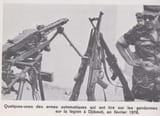A huge component of Goth Phase Germany's strategy was pitting their own staff against one another, in a bit of a Darwinian struggle. This led to some... Silliness. The STG-44, for example, was first produced as the MP-44, to keep the brass from rejecting the project outright. That was Little Dark Age Germany's legacy in weapons development; Fancy resources, world class designers, constant infighting, and an expensive Wunderwaffle for every occasion.
>>64175842 (OP)
Considering their insistence on traditionalism, and internal mythology, Germany (maybe?) wouldn't have adopted H&K-style designs such as those shown. That adoption would also be difficult because of the G3's development path: A German improvement upon a Spanish iteration of a German prototype. Germany wins, the STG-45 stays under wraps, the CETME Model-58 is never built... You get the idea. It gets hairy, fast.
Then, there's Germany's victory. This ain't that discussion, but to keep it a buck fifty: The moment America entered, Germany was screwed. Some would say that the moment Germany made an enemy of the USSR, they had already lost. Basically, depending on how they win in this scenario, and how they win, the whole game changes. It's a butterfly effect. Germany wins, America never enters the war, John Garand continues happily ice-skating in his basement, the M14 is never developed, its lackluster performance never generates the impetus for the adoption of the M16, so on, so forth. It devolves into Asimov's psychohistory; Most of the same developments (Polymer receivers, intermediate cartridges, equivalents to the fire team), none of the same players, with random variables changing the entire pattern at random.
And then, there's the simple fact that Nightcore Germany was burning social capital, itching to go to war with the entire world at the same time. They were allergic to winning, no matter which cool tech they developed.
Long story short, you get one major benefit: No rear charging handles.








